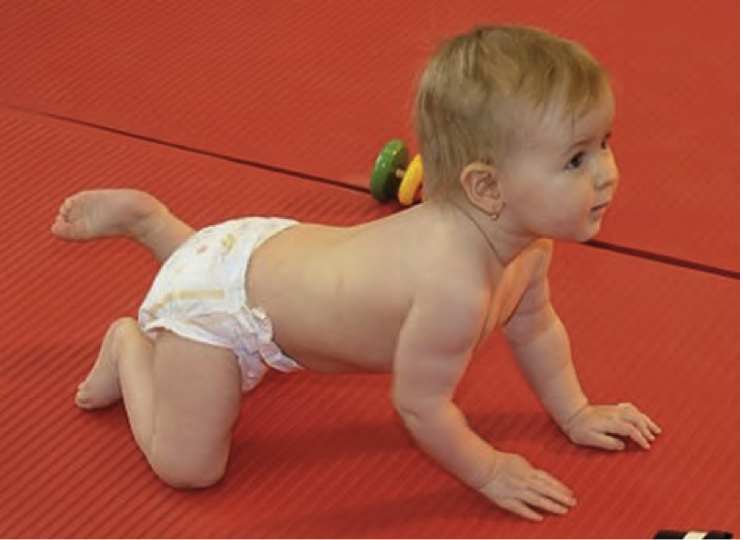By Randi Kinney, PT, DPT, MTC
Unlike other animals, human movement is not mature at birth, and our anatomical structure is not perfectly developed. Think of the difference of a newborn baby versus a newborn horse or puppy. The horse or puppy come out of the womb and can move in their environment right away, whereas newborn human movements are purely reflexive; not purposeful, coordinated movements.
Purposeful, voluntary human movement does not occur until maturation of the Central Nervous System (CNS) occurs. The CNS, consisting of the brain and the spinal cord, integrates information it receives from all parts of the body through different sensory systems, and then coordinates movement and influences human activity.
We can think of it as the “control center” for movement and muscle functions. It takes time for the CNS to mature, and as it matures, purposeful muscle function and actions become increasingly activated.
As a pediatric and adult physical therapist, it is important for me to understand the different levels of CNS maturation and the role it plays in postural stability, functional mobility, and the development of proper locomotion patterns important for upright walking and running. It is also important to recognize that the maturation of the CNS occurs automatically and in a genetically pre-determined sequence.
For instance, an infant does not need to be taught when and how to lift her head, grasp a toy, turn around, roll over, or start crawling. These movement patterns are automatically formed as the CNS continues to mature, thus allowing the infant to control posture, achieve erect posture against gravity, and to ultimately achieve controlled purposeful movement.
It is also important to understand that despite the automatic maturation of the CNS, occurring in a pre-determined sequence, the maturation process can be affected and altered by external and environmental factors, thus altering normal development. This is when we can expect to see structural, functional or even cognitive dysfunctions and developmental impairments.
Furthermore, ideal structural development and anatomic maturation depends on CNS control of muscle function. Correct CNS control ensures proportional activation between muscle groups, which allows for ideal skeletal maturation.
As physical therapists we call this “coordinated co-contraction of antagonists,” meaning, proper muscle control and activation occurring around a joint to create a harmonious influence on the growth plates to ensure proper structural development. This proper muscle control and muscle activation is achieved through the pre-determined sequence of developmental movement patterns mentioned above.
So what’s the take home message here?
Function governs structure and structure governs function
Normal development of human movement follows a sequence for a specific and purposeful reason. Kids need to learn how to roll over before they crawl, crawl before they bear crawl, and bear crawl before they walk. These movement patterns, and their specific developmental order ensure that the child is gaining stability through their core, trunk, and shoulder girdle prior to controlling the movement of their upper and lower extremities.
During development it is important that stabilization occurs initially in the spine, chest and pelvis and only then it is followed by phasic extremity function. Walking, running and supporting extremity functions fully depend on trunk stabilization, which depends on proper structural development.
In part 2, I will talk about how rolling, crawling, and other primal movement patterns help us determine the true cause of movement dysfunction. You will see how this information informs how to best assess and treat common movement problems that are seen in many children, and persist into adulthood.
About Dr. Randi Kinney, PT, DPT, MTC
Dr. Kinney is a physical therapist, with a certification in manual therapy (MTC). She is the director of Water and Sports Physical Therapy’s Scripps Ranch Clinic, director of Pediatrics and the supervisor and coordinator of the elite exercise specialist program which entails the education of advanced land and aquatic exercise.
Picture Reference:
Kobesova, A., Kolar, P., Developmental kinesiology: Three levels of motor control in the assessment and treatment of the motor system, Journal of Bodywork & Movement Therapies (2013), https://dx.doi.org/10.1016/j.jbmt.2013.04.002
Craig Valency, MA, CSCS, president and co-founder of SPIDERfit, has been a personal trainer for the last 11 years. He is currently working at Fitness Quest 10 in San Diego, an elite personal training and athletic conditioning facility. He specializes in youth strength and conditioning programs that promote physical literacy, injury prevention and optimal performance. Along with training youths from 6 to 18 years of age for general fitness, Craig has also worked with some of the top junior tennis players in the world. He has been a physical education consultant for the Stevens Point school district in Wisconsin for the last 3 years, helping revamp the district wide programming for the K-12 PE curriculum. Craig earned his bachelor degree from UCLA, and Masters Degree in Kinesiology from San Diego State University.





Connect with SPIDERfit!